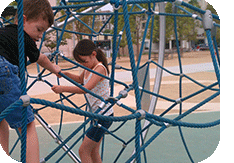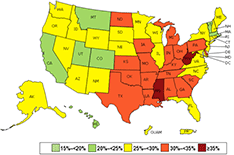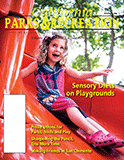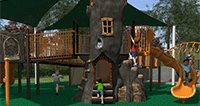|
|
Combating Obesity Through Play
Author: Chad Kennedy, Landscape Architect, ASLA
 As I observe young toddlers playing in the park, at their homes, or at school, I often contemplate their seemingly innate need to run from one activity to the next. Despite the fact that they trip, fall, break and bang into things, running is the preferred method of transition, regardless of the activity or endeavor. How many knees are scraped, glasses of milk spilt, and cranial contusions occur each day because of this reckless behavior? It is almost physically draining to watch as an observer! An attentive onlooker, however, might learn a thing or two from this unlearned drive to engage in physical vigor. If toddlers only continued to engage in similar forms of vigorous movement as they grew into adolescence and adulthood, the issues of obesity and lack of physical health that face our society today would certainly not exist. The reality is however, that most of us slow down as we age, finding it more of a burden than an advantage to exert a toddler-like level of energy, often leading to less than healthy weight and activity levels. This leads to several questions. How big of an issue is obesity in the United States? Are there ways to combat the obesity trend by keeping children interested in active behaviors as they grow older? What can parents do to help? As I observe young toddlers playing in the park, at their homes, or at school, I often contemplate their seemingly innate need to run from one activity to the next. Despite the fact that they trip, fall, break and bang into things, running is the preferred method of transition, regardless of the activity or endeavor. How many knees are scraped, glasses of milk spilt, and cranial contusions occur each day because of this reckless behavior? It is almost physically draining to watch as an observer! An attentive onlooker, however, might learn a thing or two from this unlearned drive to engage in physical vigor. If toddlers only continued to engage in similar forms of vigorous movement as they grew into adolescence and adulthood, the issues of obesity and lack of physical health that face our society today would certainly not exist. The reality is however, that most of us slow down as we age, finding it more of a burden than an advantage to exert a toddler-like level of energy, often leading to less than healthy weight and activity levels. This leads to several questions. How big of an issue is obesity in the United States? Are there ways to combat the obesity trend by keeping children interested in active behaviors as they grow older? What can parents do to help?
 Prevalence of Obesity in the United States Prevalence of Obesity in the United States
According to the Center for Disease Control (CDC), in 2012, 8.4% of 2-5 year olds, 17.7% of 6-11 year olds and 20.5% of 12-19 year olds were considered obese.6 The most recent results of obesity, shown in the graphic to the right, reveal that obesity is still on the rise despite efforts to combat it. The only exception to this was California which had rates reportedly lower than the last survey in 2012.7 The CDC suggested level of aerobic activity per day is sixty minutes. Interestingly, only 18% of high school age children met this recommendation in 2007, perhaps highly correlated with a lack of access to physical education as evidenced by a study in 2001 which revealed only 6.7% of schools K-12 provided daily physical education classes.1 This is alarming because lack of physical activity leads to many health issues related to obesity such as cardiovascular disease, high blood pressure, asthma, sleep apnea, diabetes and other psychosocial risks such as social discrimination, low self-esteem and hindered social functioning.8
In recent years there has been a great deal of interest in the levels of obesity. Many studies and programs have focused on education, healthy eating and promoting active movement, however, very few programs have actually focused on the built environment and providing places for active movement and recreation.2
Combating Obesity Through the Built Environment
One of the most important aspects of an active lifestyle is safe appealing places for recreation and exercise. In America, it is estimated that only half of all children have access to neighborhood parks, open space or community centers.3 There are only a few programs throughout the nation designed to address this issue, and even fewer that focus on children's developmental social, emotional and cognitive needs.2 Below are a few ideas for providing more quantity and better quality open spaces to promote active movement.
Time outdoors - Studies have shown very strong correlations between activity levels and the amount of time spent outdoors. In areas where it is unsafe to play outside the home, parks, playgrounds and recreational facilities are a necessity. Proper planning and locating of these facilities is crucial. 1 Socially inclusive spaces - The creation of social spaces where children are encouraged and even required to interact and participate together extend active play times. This is particularly important for children with developmental challenges that tend not to interact with other children or who are physically unable to access play features. Removal of perceived and actual barriers - Studies have shown that children react negatively to physical activity when barriers are encountered, whether real or perceived.1 These barriers can be manifest as accessibility issues, level of difficulty in play elements, sense of insecurity, geographic distance, lack of shade and lack of areas for respite. These and many other barriers can be easily avoided with thoughtful planning during the design process, resulting in enjoyable spaces that encourage active motion. Technology Integration - The play community has begun to embrace the generation Z population of children who don't know a world without the internet or cell phones. The technology they expect can now be integrated into their outdoor play environments through interactive play equipment, cell phone apps and recreational games. The effectiveness of integrating these technologies is undocumented, though the intention is to encourage an increase in time spent outdoors. Community gardening - Community gardens can improve activity and health by those directly involved in the cultivation and harvest of foods and flowers. (Studies have shown that gardening three to four times a week is comparable to moderate walking and biking.) Diversity in play - Providing a diversity of play opportunities, across the spectrum of user groups regardless of age and physical abilities, will encourage inter-generational play, maintain interest for longer periods of time and more evenly address children's developmental needs. The goal is to create an environment where children and adults alike prefer not to return home because the environment is so much more inviting and enjoyable than what is afforded at home.
Parental Role in Obesity
Though children are in school for a significant portion of the day it is not feasible to meet children's quota for physical activity during that period of time. It falls upon parents to ensure that opportunities exist around the home and in local open spaces. Below are a few ideas of how to be pro-active in children's health:
 Play together - A study conducted in 2000 showed a direct correlation between parent or sibling activity and adolescent physical activity.1 In other words, if families play together, they all tend to be more active as a group resulting in better health. Play together - A study conducted in 2000 showed a direct correlation between parent or sibling activity and adolescent physical activity.1 In other words, if families play together, they all tend to be more active as a group resulting in better health.
Limit screen time - Limiting time in front of the television can be a great way of keeping children active. It not only allows for more time that can be filled with activities, but limits increased food and calorie intake often associated with viewing television. Studies have consistently shown positive associations between prevalence of obesity and increased length in television viewing times.1 Don't over plan - It is important to remember that not all activity must be a formal planned activity. Impromptu walks to the corner market, a game of tag in the back yard and hopscotch on the driveway are all excellent ways of spending time outside and increasing exposure to physical activity.
Not one single approach will cure the issues our society faces with children's health and obesity rates. Proper planning of play spaces, where toddler-like energy can be dissipated, is however a must, and should be considered a crucial element complimenting those of education, healthy diets and activity programming.
To learn more about landscape architecture related topics please visit our publications center.
1-Koplan, Jeffrey P., Catharyn T. Liverman and Vivica A. Kraak. Preventing Childhood Obesity: Health in the Balance. National Academies of Science. ISBN 0-309-53164-0. 2005.
2-Segal. Elliot A. Fighting Obesity: What Works, What's Promising. HSC Foundation. Washington D.C. August 2009.
3-Center for Disease Control. A Growing Problem. April 17 2013. September 2014. www.cdc.gov/obesity/childhood/problem.html
4-Center for Disease Control. Healthy Weight: Tips for Parents. October 31 2011. September 2014. www.cdc.gov/healthyweight/children/index.html
5-Center for Disease Control. How Much Physical Activity Do Children Need?. November 9 2011. September 2014. www.cdc.gov/physicalactivity/everyone/guidelines/children.html
6-Center for Disease Control. Childhood Obesity Facts. September 3 2014. September 2014. www.cdc.gov/obesity/data/childhood.html
7-Center for Disease Control. Prevalence of Self-Reported Obesity Among U.S. Adults by State. September 2014. September 2014. www.cdc.gov/obesity/data/prevalence-maps.html
8-Center for Disease Control. Tips for Parents: Ideas to Help Children Maintain A Healthy Weight. October 31 2011 . September 2014. www.cdc.gov/healthyweight/children/index.html
|
|
|
|
 As I observe young toddlers playing in the park, at their homes, or at school, I often contemplate their seemingly innate need to run from one activity to the next. Despite the fact that they trip, fall, break and bang into things, running is the preferred method of transition, regardless of the activity or endeavor. How many knees are scraped, glasses of milk spilt, and cranial contusions occur each day because of this reckless behavior? It is almost physically draining to watch as an observer! An attentive onlooker, however, might learn a thing or two from this unlearned drive to engage in physical vigor. If toddlers only continued to engage in similar forms of vigorous movement as they grew into adolescence and adulthood, the issues of obesity and lack of physical health that face our society today would certainly not exist. The reality is however, that most of us slow down as we age, finding it more of a burden than an advantage to exert a toddler-like level of energy, often leading to less than healthy weight and activity levels. This leads to several questions. How big of an issue is obesity in the United States? Are there ways to combat the obesity trend by keeping children interested in active behaviors as they grow older? What can parents do to help?
As I observe young toddlers playing in the park, at their homes, or at school, I often contemplate their seemingly innate need to run from one activity to the next. Despite the fact that they trip, fall, break and bang into things, running is the preferred method of transition, regardless of the activity or endeavor. How many knees are scraped, glasses of milk spilt, and cranial contusions occur each day because of this reckless behavior? It is almost physically draining to watch as an observer! An attentive onlooker, however, might learn a thing or two from this unlearned drive to engage in physical vigor. If toddlers only continued to engage in similar forms of vigorous movement as they grew into adolescence and adulthood, the issues of obesity and lack of physical health that face our society today would certainly not exist. The reality is however, that most of us slow down as we age, finding it more of a burden than an advantage to exert a toddler-like level of energy, often leading to less than healthy weight and activity levels. This leads to several questions. How big of an issue is obesity in the United States? Are there ways to combat the obesity trend by keeping children interested in active behaviors as they grow older? What can parents do to help? Prevalence of Obesity in the United States
Prevalence of Obesity in the United States  Play together - A study conducted in 2000 showed a direct correlation between parent or sibling activity and adolescent physical activity.1 In other words, if families play together, they all tend to be more active as a group resulting in better health.
Play together - A study conducted in 2000 showed a direct correlation between parent or sibling activity and adolescent physical activity.1 In other words, if families play together, they all tend to be more active as a group resulting in better health.
